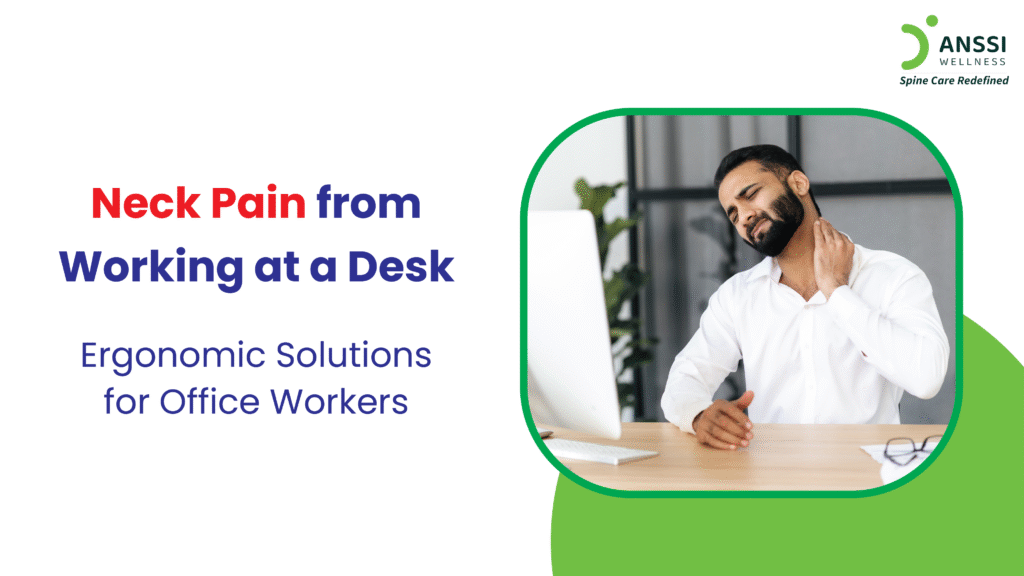In today’s digital age, millions of us spend long hours hunched over computers, attending virtual meetings, and working at desks, often without paying attention to posture. As a result, neck pain has become a widespread issue among office workers. This seemingly small problem can escalate into chronic discomfort, headaches, stiffness, and even reduced productivity.
The good news? You can prevent, or even reverse, most desk-related neck pain with simple ergonomic adjustments and healthy movement habits.
Causes of Desk-Related Neck Pain
Neck pain linked to desk work isn’t caused by one major event but rather by repetitive strain and prolonged poor posture.
Here are some of the most common causes:
Forward Head Posture
This happens when your head sticks out forward while looking at a screen. For every inch your head moves forward, it adds extra pressure on your neck muscles, leading to tension and pain.
Poor Screen Height
If your computer monitor is too low or too high, your neck ends up bending unnaturally for hours, causing strain on the cervical spine.
Lack of Movement
Sitting for long stretches without moving reduces blood flow and stiffens the muscles. It also compresses spinal discs, increasing the risk of disc degeneration or bulges.
Unsupported Sitting Position
Chairs without proper back support, especially for the lower back, cause misalignment in the spine. This affects neck posture as your upper body tries to compensate.
Ergonomic Solutions to Prevent Neck Pain
The key to preventing neck pain is prevention. Fortunately, small, mindful changes in your workstation setup and daily habits can lead to significant improvements.
Adjust Your Chair Height and Back Support
Your feet should rest flat on the floor, and your knees should be at the same height or slightly lower than your hips. Use a chair that supports your lower back or add a small cushion behind your lumbar spine. This encourages a neutral spine position, which helps the neck stay aligned.
Keep Your Monitor at Eye Level
Your monitor should be directly in front of you with the top of the screen at or slightly below eye level. This keeps your neck from tilting up or down, reducing muscle strain. If you use a laptop, think about getting an external monitor or a laptop stand.
Use a Headset or Speakerphone
If you’re frequently on calls, avoid placing your phone between your shoulder and ear. That’s a guaranteed way to stress your neck. Use a headset, earbuds, or speakerphone to keep your hands free and your head upright.
Maintain 90-Degree Angles for Arms and Knees
Your elbows should be close to your torso and bent at a 90-degree angle when typing or using a mouse. Your wrists should be straight and supported. Likewise, your knees should also be at a 90-degree angle with feet resting on the floor or a footrest.
Take Micro-Breaks Every 30-60 Minutes
To remind yourself to stand, stretch, or go for a quick stroll every hour, set a timer. Even 2-3 minutes of movement can relax stiff muscles, improve circulation, and relieve pressure on your spine. Try neck rolls, shoulder shrugs, or gentle upper back stretches at your desk.
Additional Tips to Support Neck Health
In addition to setting up your workstation correctly, adopting the following habits can help relieve and prevent neck pain:
- Stay Hydrated: Water is necessary for your spinal discs to remain supple and cushioned. Dehydration can contribute to disc stiffness and neck pain.
- Practise Deep Breathing and Mindfulness: Stress frequently causes tension to accumulate in the shoulders and neck. Taking deep breaths and being mindful of your posture during the day can help you catch and correct bad habits early.
- Improve Your Sleep Posture: Poor sleeping positions can undo all your daytime efforts. Do not sleep on your stomach and use a pillow that supports the natural curvature of your neck.
- Include Regular Physical Activity: Strengthening your core, upper back, and shoulders with regular exercise enhances your posture and supports the neck. Activities like yoga, swimming, or walking are gentle yet effective.
About ANSSI:
ANSSI Wellness focuses on improving the quality of life for patients suffering from spinal issues, aiming to provide relief where other conventional treatments have failed. Through advanced non-surgical spinal decompression treatment, ANSSI is committed to helping patients avoid surgery and recover in a safe, effective, and compassionate environment.
Connect with ANSSI Wellness on LinkedIn, Instagram, and Facebook for expert guidance.



